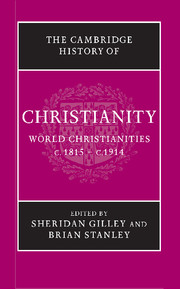Book contents
- Frontmatter
- 1 Introduction
- PART I CHRISTIANITY AND MODERNITY
- PART II THE CHURCHES AND NATIONAL IDENTITIES
- 14 Catholic Christianity in France from the Restoration to the separation of church and state, 1815–1905
- 15 Italy: the church and the Risorgimento
- 16 Catholicism, Ireland and the Irish diaspora
- 17 Catholic nationalism in Greater Hungary and Poland
- 18 Christianity and the creation of Germany
- 19 Anglicanism, Presbyterianism and the religious identities of the United Kingdom
- 20 Protestant dominance and confessional politics: Switzerland and the Netherlands
- 21 Scandinavia: Lutheranism and national identity
- 22 ‘Christian America’ and ‘Christian Canada’
- 23 Spain and Portugal: the challenge to the church
- 24 Latin America: the church and national independence
- 25 Between east and west: the Eastern Catholic (‘Uniate’) churches
- PART III THE EXPANSION OF CHRISTIANITY
- Select General Bibliography
- Chapter Bibliography
- Index
- References
24 - Latin America: the church and national independence
from PART II - THE CHURCHES AND NATIONAL IDENTITIES
Published online by Cambridge University Press: 28 March 2008
- Frontmatter
- 1 Introduction
- PART I CHRISTIANITY AND MODERNITY
- PART II THE CHURCHES AND NATIONAL IDENTITIES
- 14 Catholic Christianity in France from the Restoration to the separation of church and state, 1815–1905
- 15 Italy: the church and the Risorgimento
- 16 Catholicism, Ireland and the Irish diaspora
- 17 Catholic nationalism in Greater Hungary and Poland
- 18 Christianity and the creation of Germany
- 19 Anglicanism, Presbyterianism and the religious identities of the United Kingdom
- 20 Protestant dominance and confessional politics: Switzerland and the Netherlands
- 21 Scandinavia: Lutheranism and national identity
- 22 ‘Christian America’ and ‘Christian Canada’
- 23 Spain and Portugal: the challenge to the church
- 24 Latin America: the church and national independence
- 25 Between east and west: the Eastern Catholic (‘Uniate’) churches
- PART III THE EXPANSION OF CHRISTIANITY
- Select General Bibliography
- Chapter Bibliography
- Index
- References
Summary
The post-colonial church
The collapse of the Bourbon state and the onset of colonial rebellion in Spanish America were observed by the church not simply as secular events but as a conflict of ideologies and a struggle for power that vitally affected its own interests. Controlled as it was by the colonial state, the Bourbon church reacted to the trials of the state. And in the war of ideas the church saw allegiance to Spain, obedience to monarchy and repudiation of revolution as moral imperatives and their denial as a sin. Yet the church in America did not speak with a single voice.
The majority of the bishops rejected the revolution and remained loyal to Spain. They owed their appointments to the crown, they had sworn allegiance to the king, and they were under immediate pressure to conform and deliver to the king a docile people. Bishops were urged ‘to cooperate by their example and their doctrine in preserving the rights of legitimate sovereignty which belongs to the king our lord’. During these years bishops helped to finance, arm and activate anti-insurgency forces, and they launched weapons as well as anathemas against their enemies.
The clergy were divided but many, especially among the lower clergy who were predominantly creole (American-born), supported the cause of independence. Some priests played leading roles in the struggle, many more were activists in the rebel ranks, and numerous volunteers served as chaplains in the armies of liberation. In Mexico the early insurgency was dominated by priests, two in particular: Miguel Hidalgo, a country priest of progressive views, and José María Morelos, another reformist and a natural guerrilla leader. On their defeat they were not only executed by royal authority but also condemned and excommunicated by the church.
- Type
- Chapter
- Information
- The Cambridge History of Christianity , pp. 395 - 411Publisher: Cambridge University PressPrint publication year: 2005
References
- 1
- Cited by

